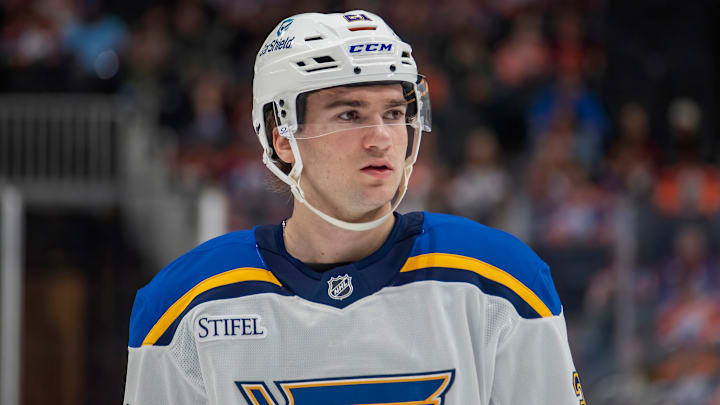Entering the 2025-26 season, the St. Louis Blues are at a crossroads. Are they still trying to squeeze wins out of the current core, or retooling toward the next wave? The answer may lie in how they choose to deploy rookie winger Jimmy Snuggerud.
Giving Snuggerud a first-line role right out of the gate accelerates the organization's transition and signals belief in the youth movement. But would it be reckless for the Blues to put so much trust in a 21-year-old with just a handful of NHL games under his belt?
It's a fascinating debate, and one that gets right to the heart of how the Blues are trying to shape their identity for 2025-26. Betting on Snuggerud’s upside in a first-line role carries both risk and reward, especially when compared with giving that ice time to an established but inconsistent scorer like Jordan Kyrou.
Why Blues betting on Jimmy Snuggerud in first-line role could pay off
Snuggerud’s calling card is his NHL-ready shot – heavy, accurate and quick. On a first line with Robert Thomas feeding pucks, he could convert chances at a high clip, giving the Blues a more lethal top-line finisher than Kyrou, who leans more on transition and playmaking.
The Blues already have speed and creativity in Thomas. Snuggerud’s game – finding soft spots, shooting from dangerous areas – arguably meshes better with Thomas than that of another puck-carrier like Kyrou.
A rookie with upside can also energize both fans and the locker room. If Snuggerud adapts quickly, the Blues suddenly have a cheap, controllable, top-line winger, which is a massive roster-building win.
Why Blues giving first-line minutes to Jimmy Snuggerud might be too much, too soon
Of course, the primary argument against Snuggerud getting first-line opportunities with the Blues in 2025-26 is based on his lack of pro experience. Throwing him in for 18-20 minutes a night against top defenders risks exposing weaknesses (e.g., pace, defensive reads, physical play) that may have been easier to hide in college.
Trusting Snuggerud in an elevated role early in the season also places him under a considerable amount of pressure. If he struggles early on the first line, his confidence could take a hit, especially under the microscope of being a “solution” for a team that badly needs top-line consistency.
Many young players benefit from starting in middle-six roles with softer matchups before being elevated. Skipping that step could stunt Snuggerud’s growth if he’s overwhelmed.
The bottom line
For all his flaws, Kyrou has produced three 70-point seasons in his career. If the Blues want to maximize 2025-26 wins immediately, leaning on the more experienced winger for first-line minutes is safer. They know he can at least drive offense at the NHL level, even if inconsistently.
On the other hand, if the Blues are willing to take a calculated gamble on upside, Snuggerud’s shot and IQ make him a legitimate candidate to break out – especially next to Thomas. The payoff could be huge: a cheap, top-line scoring winger who changes the team’s trajectory.
The smartest path may be a hybrid: start Snuggerud in a sheltered top-six role (on the second line, getting power play reps), but give him chances with Thomas in stretches. If the chemistry clicks, then it’s not reckless; it’s forward-thinking.
